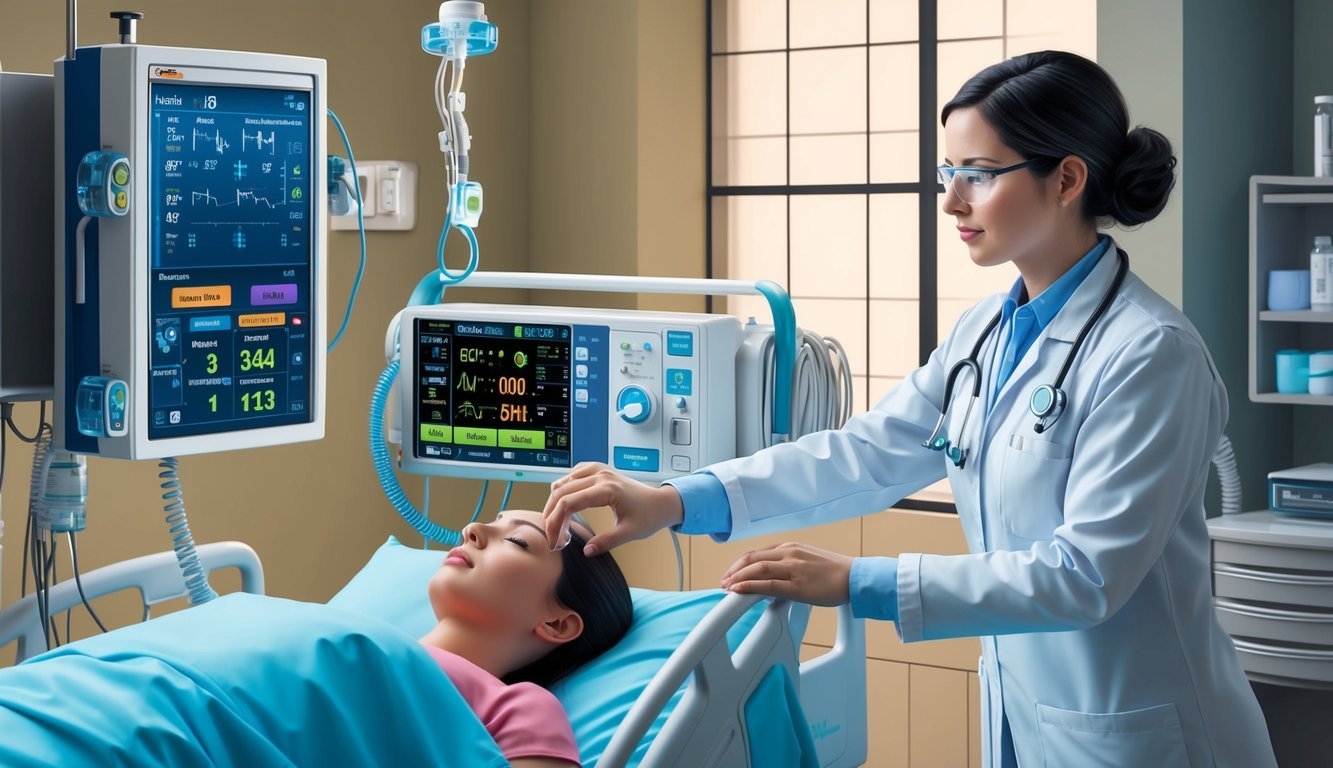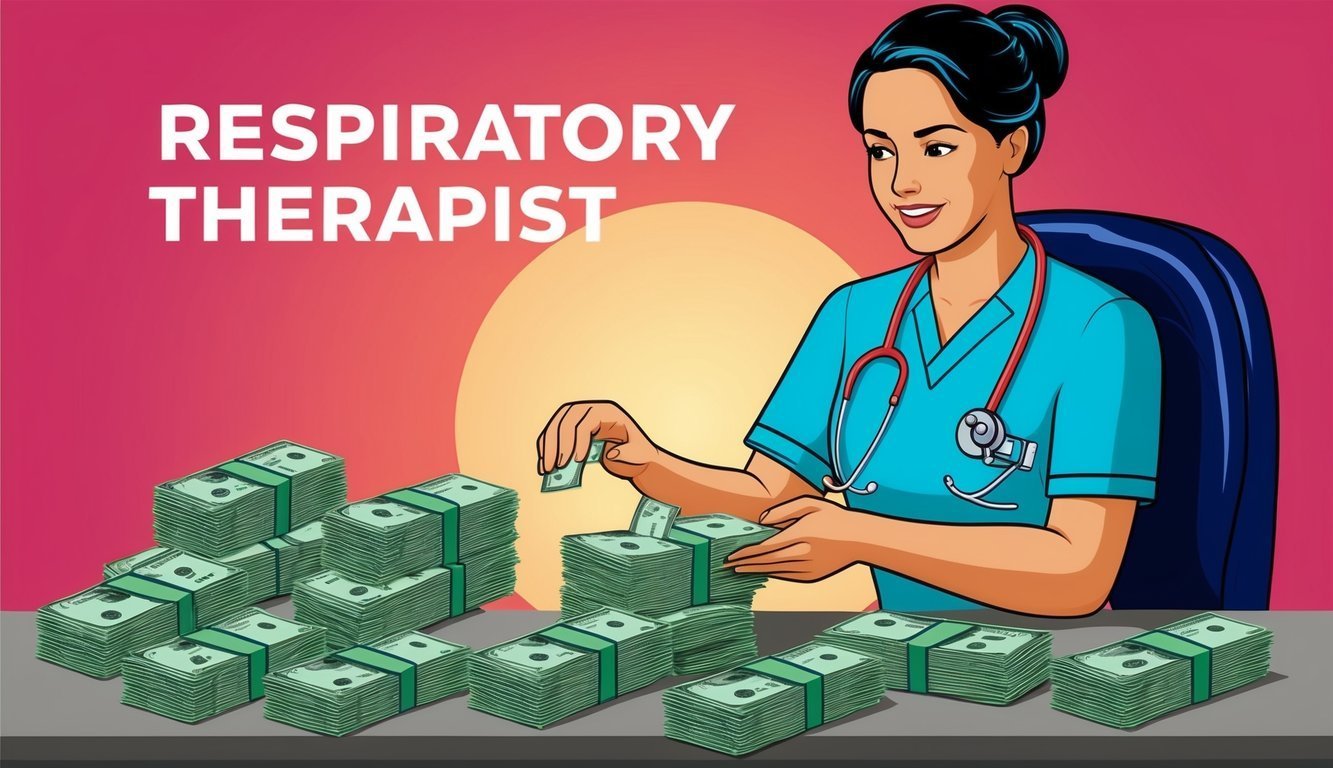As a respiratory therapist, you play a vital role in the healthcare system, providing essential care to patients with respiratory issues.
Understanding your earning potential is crucial as you consider this rewarding career.
The average salary for respiratory therapists in the United States is around $77,960 annually, with significant variations depending on your location, experience, and work setting.
Several factors influence respiratory therapist salaries, including state-specific demand and the type of healthcare facility.
For example, positions in urban hospitals may offer higher wages due to increased patient volume and the complexity of cases.
To get a clearer picture, it’s helpful to explore salary ranges across different states and settings, allowing you to make informed decisions about your career trajectory.
By examining the latest data and trends, you can better navigate your career as a respiratory therapist.
Information on salary variations can be found through resources such as Nurse.org and Salary.com, which provide insights into what you can expect based on your qualifications and location.
Educational Pathways and Credentials
To become a respiratory therapist, you must follow specific educational pathways and meet certain credentials.
The journey typically begins with obtaining an associate degree in respiratory therapy.
The program should be accredited by the Commission on Accreditation for Respiratory Care (CoARC).
Key Credentialing Steps
-
Earn an Associate or Bachelor’s Degree
Enroll in an accredited program to gain the necessary knowledge and skills. -
Obtain Certification
You will need to become a Certified Respiratory Therapist (CRT). This credential demonstrates your foundational skills. -
Advance to Registered Respiratory Therapist (RRT)
To enhance your career prospects and salary potential, you may pursue the RRT credential. This requires passing additional exams.
Overview of Credentials
| Credential | Description |
|---|---|
| Certified Respiratory Therapist (CRT) | Entry-level certification. |
| Registered Respiratory Therapist (RRT) | Advanced certification for experienced therapists. |
Many programs now offer online healthcare programs, making it easier to balance your studies with personal commitments.
Ensure that any online courses you select are accredited.
Meeting these educational and certification requirements will prepare you for a fulfilling career in respiratory therapy.
For more information on how to become a respiratory therapist, check out this guide on how to become a respiratory therapist.
Salary Overview for Respiratory Therapists
Understanding the salary landscape for respiratory therapists is crucial for those considering this career path.
Key factors such as location, experience, and job demand play significant roles in determining compensation.
Factors Influencing Salary
Several factors affect the salary you can expect as a respiratory therapist.
Experience level is a primary consideration; more experienced therapists often command higher wages.
According to the U.S. Bureau of Labor Statistics, respiratory therapists with less than one year of experience earn around $25.82 per hour, while those with 5-9 years can earn about $30.42 per hour.
Another important factor is geographical location.
States like California and New York are known for higher salary ranges due to a higher cost of living and increased demand for healthcare services.
Additionally, certifications, specialized training, and the type of healthcare facility also influence earnings.
Average Salary across the U.S.
On average, respiratory therapists earn approximately $77,643 annually or about $44.22 per hour in the United States.
The median salary is comparable, with many therapists earning between $70,000 and $84,000.
The Bureau of Labor Statistics projects employment growth in this field at around 13% from 2023 to 2033, indicating a steady demand for qualified therapists.
For those seeking opportunities in city settings, urban areas tend to offer competitive salaries, often exceeding the national average.
Senior positions often provide additional financial opportunities through bonuses or other incentives.
Respiratory Therapist Salary by State
Salaries for respiratory therapists can vary widely by state.
The following table summarizes average salaries in some of the highest-paying states:
| State | Average Annual Salary |
|---|---|
| California | $84,198 |
| New York | $82,000 |
| New Jersey | $78,500 |
| Washington | $76,000 |
| Alaska | $75,000 |
These figures show that working in specific states or cities can significantly impact your potential earnings.
Many high-paying cities for respiratory therapists offer opportunities that may enhance your career and financial prospects.
For further details, you can explore U.S. Bureau of Labor Statistics statistics.
Specializations and Advanced Practices
In the field of respiratory therapy, several specializations focus on specific patient needs and require advanced skills.
Understanding these areas can enhance your career and improve patient outcomes.
Pulmonary and Critical Care
In pulmonary and critical care, you will work with patients suffering from chronic obstructive pulmonary disease (COPD), asthma, and other serious respiratory conditions.
This specialization involves managing acute respiratory distress and providing advanced respiratory therapies.
You’ll assess and monitor patients in critical care settings, delivering therapeutic interventions such as mechanical ventilation and non-invasive positive pressure ventilation.
Your role is crucial in managing conditions like pneumonia and chronic bronchitis, ensuring optimal oxygenation and airway management.
Additionally, advanced practitioners often collaborate with physicians to develop treatment plans that address complex pulmonary diseases.
Knowledge of pharmacological treatments and pulmonary rehabilitation is essential in this field.
Pediatric and Neonatal Care
Working in pediatric and neonatal care, you cater to infants and children with various respiratory issues.
Conditions may include bronchopulmonary dysplasia, respiratory distress syndrome, and sleep apnea.
Your expertise in this area ensures that young patients receive the specialized care they require.
You will perform delicate procedures, including airway suctioning and administering aerosol therapies, tailored to younger patients.
Understanding growth and development in respiratory care is crucial for accurate assessments and effective treatment plans.
Collaboration with a multidisciplinary team of pediatricians, nurses, and other healthcare professionals is essential for providing comprehensive care.
Family education also plays a central role, helping parents understand their child’s needs.
Sleep Disorders and Therapies
Sleep disorders, particularly sleep apnea, significantly impact respiratory health.
In this specialty, you will evaluate and treat conditions affecting sleep quality and breathing during rest.
Advanced diagnostic tools like polysomnography are often utilized in your assessments.
You will provide therapeutic interventions that may include continuous positive airway pressure (CPAP) therapy or other non-invasive treatments.
Understanding the relationship between respiratory function and sleep patterns allows you to tailor interventions effectively.
Collaboration with sleep specialists to create comprehensive treatment plans is vital.
Education on lifestyle modifications and adherence to therapy can improve your patient’s quality of life, making this specialization both rewarding and impactful.
For more information on treatment options, you can explore resources at American Academy of Sleep Medicine.
Job Market and Opportunities
The job market for respiratory therapists is robust, with numerous opportunities available across various healthcare settings.
The growing demand for respiratory care services ensures that you can find a position that fits your career goals and lifestyle.
Employment Settings
Respiratory therapists work in a variety of settings, including:
- Hospitals: The majority of respiratory therapists are employed in acute care hospitals, where they manage patients requiring emergency and intensive care.
- Outpatient Clinics: These facilities focus on chronic respiratory conditions, providing therapy and education for patients.
- Home Healthcare: You may assist patients in their homes, managing ventilation and oxygen therapy needs.
- Rehabilitation Centers: These settings often involve patients recovering from respiratory illnesses or surgeries.
In each of these environments, you’ll have the chance to collaborate with other healthcare professionals, enhancing the overall patient care experience.
Job Growth Projection
The employment outlook for respiratory therapists is promising, with projections indicating significant job growth.
According to the Bureau of Labor Statistics, employment is expected to grow by 13% from 2023 to 2033, which is much faster than the average for all occupations.
This growth translates to approximately 8,200 job openings annually, driven by the increasing need for respiratory services, especially in light of an aging population.
Maximizing Earning Potential

To increase your earnings as a respiratory therapist, focus on strategic negotiation and pursue continuing education opportunities.
These steps can significantly enhance your salary and career prospects.
Negotiating Salaries and Benefits
When considering a job offer, negotiation is crucial.
Start by researching industry standards for salaries specific to your location and specialization.
Use resources like the U.S. Bureau of Labor Statistics to gather data.
Be prepared to discuss your qualifications, skills, and previous experience during negotiations.
Highlight any specialized training or certifications you possess.
Approach your employer with a clear understanding of your worth based on market trends.
Consider also negotiating benefits, such as flexible hours, which can help improve job satisfaction and work-life balance.
Tailoring your approach to fit both your needs and the employer’s can lead to higher pay and better benefits.
Continuing Education and Career Ladder
Investing in further education can open doors to higher-paying positions within respiratory therapy.
Pursuing advanced certifications, such as those related to neonatal or pediatric therapy, can increase your marketability.
Consider these qualifications for career growth:
| Qualification | Potential Salary Increase |
|---|---|
| Certified Respiratory Therapist (CRT) | Base salary level |
| Registered Respiratory Therapist (RRT) | $5,000 – $10,000 increase |
| Specialized certifications (e.g., sleep therapy) | $10,000+ increase |
Participating in workshops, seminars, and conferences can also enhance your skills.
You should also seek opportunities for advancement, such as supervisory roles or education positions.
Engaging in continuous education signals your commitment to professionalism, ultimately leading to a more lucrative career.

